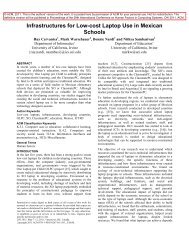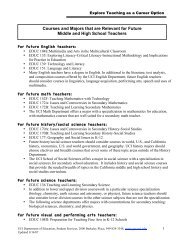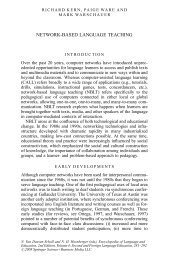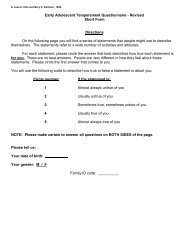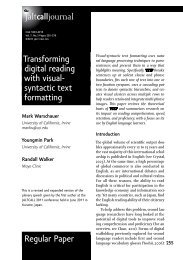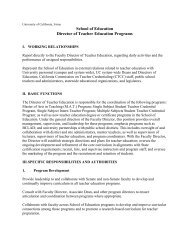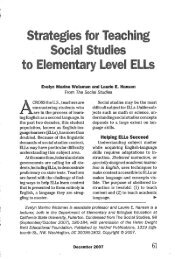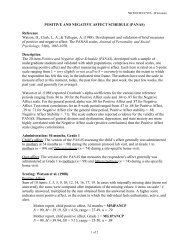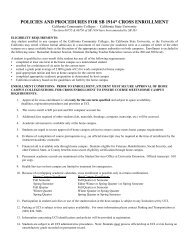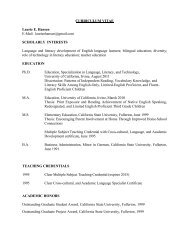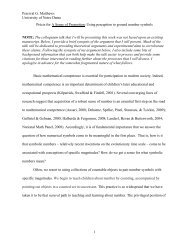Interactive Strategies for Teaching Students Response to Literature
Interactive Strategies for Teaching Students Response to Literature
Interactive Strategies for Teaching Students Response to Literature
Create successful ePaper yourself
Turn your PDF publications into a flip-book with our unique Google optimized e-Paper software.
<strong>Interactive</strong> <strong>Strategies</strong> <strong>for</strong><br />
<strong>Teaching</strong> <strong>Students</strong> <strong>Response</strong> <strong>to</strong><br />
<strong>Literature</strong><br />
Carol Booth Olson<br />
cbolson@uci.edu<br />
Southern Nevada<br />
Regional Literacy &<br />
Social Studies Conference<br />
April 12, 2008
Reading<br />
Literal Comprehension Interpretation<br />
What the text says What the text means<br />
Writing<br />
Summary Commentary
Cali<strong>for</strong>nia Standards Test Scoring<br />
Rubric Grade 7 Writing Tasks<br />
4 The Writing<br />
� Clearly addresses all parts of the writing task<br />
� Demonstrate a clear understanding of purpose and audience<br />
� Maintains a consistent point of view, focus, and organizational structure, including<br />
the effective use of transition<br />
� Includes a variety of sentence types<br />
� Contain few, if any, errors in the conventions of the English language (grammar,<br />
punctuation, capitalization, spelling). These errors do not interfere with the<br />
reader’s understanding of the writing.<br />
<strong>Response</strong> <strong>to</strong> <strong>Literature</strong><br />
� Develops interpretations that demonstrate a thoughtful, comprehensive grasp of the<br />
text<br />
� Organizes accurate and coherent interpretations around clear ideas, premises, or<br />
images from the literary work<br />
� Provides specific textual examples and details <strong>to</strong> support the interpretations
Reading<br />
�Literary Elements<br />
�Theme<br />
Nevada English Language Arts Standards<br />
� Analyze characters, plots, setting, themes, and points of view in any<br />
given piece of literature.<br />
� Use textual evidence <strong>to</strong> analyze the theme or meaning of a selection.<br />
�Stylistic Devices<br />
Writing<br />
� Locate and interpret figurative language, including simile, metaphor, and<br />
personification in text.<br />
� Interpret examples of imagery and explain their sensory impact.<br />
� Analyze ways authors use imagery, figurative language, and sound <strong>to</strong><br />
elicit reader response.<br />
�Literary Analysis<br />
� Write responses <strong>to</strong> literary selections that demonstrate an understanding<br />
of the work, using supporting evidence from the text and prior<br />
knowledge or experience.
There is a bright little student inside most<br />
teachers, who wants <strong>to</strong> set the rest of the class<br />
straight, because he or she knows the ‘right’<br />
answer. Still, the point of teaching<br />
interpretation is not <strong>to</strong> usurp the interpreter’s<br />
role but <strong>to</strong> explain the rules of the interpretive<br />
game.<br />
Robert Scholes<br />
From Textual Power:<br />
Literary Theory in the<br />
<strong>Teaching</strong> of English, 1985
<strong>Students</strong> who engage in frequent<br />
discussions about what they read<br />
are more motivated and have higher<br />
achievement scores than students who do not<br />
interact with books.<br />
Mullis, Campbell & Farstrup, 1993<br />
Engaging students in writing<br />
about their responses <strong>to</strong> reading leads<br />
<strong>to</strong> better reading achievement.<br />
Tierney & Shanahan, 1991
Prediction<br />
� It’s about a birthday.<br />
� The gift will be money.<br />
� Someone is sad.<br />
� Something bad will happen.<br />
� It’s a poor girl’s birthday.<br />
� Someone is going <strong>to</strong> cry.<br />
� Red means attention so someone will get all the<br />
attention.<br />
� There’s something about layers.
Rachel’s Narra<strong>to</strong>r: Except when math period ends Mrs. Price says<br />
loud and in front of everybody,<br />
Mrs. Price: “Now, Rachel, that’s enough,”<br />
Rachel’s Narra<strong>to</strong>r: because she sees I’ve shoved the red sweater <strong>to</strong><br />
the tippy-tip corner of my desk and it’s hanging all over the edge like<br />
a waterfall, but I don’t care.<br />
Mrs. Price: “Rachel,”<br />
Mrs. Price’s Narra<strong>to</strong>r: Mrs. Price says. She says it like she’s<br />
getting mad.<br />
Mrs. Price: “You put that sweater on right now and no more nonsense.”<br />
Rachel: “But it’s not ---“<br />
Mrs. Price: “Now!”<br />
Mrs. Price’s Narra<strong>to</strong>r: Mrs. Price says.
�It’s about a birthday.<br />
Prediction Confirmation<br />
�The gift will be money.<br />
�Someone is sad.<br />
�Something bad will happen.<br />
�It’s a poor girl’s birthday.<br />
�Someone is going <strong>to</strong> cry.<br />
�Red means attention so<br />
�someone will get all the attention.<br />
�There’s something about layers.<br />
� It’s about a birthday but the party will<br />
come later and it has been spoiled.<br />
� This prediction did not pan out.<br />
� Yes, Rachel ends up sad.<br />
� Mrs. Price embarrasses her.<br />
� We don’t really know if Rachel is poor<br />
or not.<br />
� Yes, Rachel cries like she’s three.<br />
� She gets attention all right but it’s<br />
negative.<br />
� We all have all the years we are inside<br />
of us like layers of who we are.
“Eleven” by Sandra Cisneros<br />
What they don’t understand about birthdays and<br />
what they never tell you is that when you’re<br />
eleven, you’re also ten, and nine, and eight, and<br />
seven, six, and five, and four, and three and two<br />
and one. And when you wake up on your<br />
eleventh birthday you expect <strong>to</strong> feel eleven, but<br />
you don’t. You open eyes and everything’s just<br />
like yesterday, only it’s <strong>to</strong>day. And you don’t<br />
feel eleven at all. You feel like you’re still ten.<br />
And you are-underneath the year that makes you<br />
eleven.<br />
So, you really are like a set of<br />
stacking dolls with the person<br />
you were last year inside the<br />
person you are this year. I feel<br />
this when it’s my birthday<br />
<strong>to</strong>o. It takes a while <strong>to</strong> feel<br />
like you’re the next year old.<br />
This reminds me of what<br />
Cao said about layers.<br />
Making Connections
Figurative Language Devices<br />
Simile--A figure of speech stating a comparison using like or as.<br />
Metaphor--A figure of speech containing a comparison of two things<br />
on the basis of a shared quality as if one thing<br />
were the other.<br />
Imagery--Words and phrases that describe what is seen, smelled,<br />
tasted, or <strong>to</strong>uched which when repeated in a pattern can<br />
help <strong>to</strong> convey a particular impression about a character<br />
or situation.<br />
Symbol--A person, object, action, place or event that, in addition <strong>to</strong><br />
its literal meaning, suggests a more complex<br />
meaning or range of meaning.
<strong>Strategies</strong> <strong>for</strong> Interacting with a Text<br />
� Character Frame and Coat of Arms<br />
� <strong>Literature</strong> Portrait<br />
� Character Evolution Timeline<br />
� Split Open Mind<br />
� Framed Found Poem
"Eleven"<br />
In the s<strong>to</strong>ry "Eleven" by Sandra Cisneros, the main character, Rachel, describes an incident on her eleventh<br />
birthday that made a strong impression on her. Think about what happens <strong>to</strong> Rachel and how she feels about<br />
the incident. How does it affect the way she feels about herself?<br />
Write an essay in which you explain how you think Rachel views herself on her eleventh birthday. Consider<br />
why she sees herself as she does, what affects her view, and if her feelings about herself change as a result of her<br />
experience. How does the author show us Rachel's feelings and how do we know if those feelings change? Be sure<br />
<strong>to</strong> use specific details from the text <strong>to</strong> show why you think the way you do--including one simile or metaphor taken<br />
directly from the text and one original simile or metaphor of your own <strong>to</strong> describe Rachel's experiences. While<br />
writing your paper, remember <strong>to</strong> follow the conventions of written English.<br />
Your essay should be in standard analytical/ exposi<strong>to</strong>ry <strong>for</strong>m: introduction, main body, and conclusion.<br />
The best papers will:<br />
� Begin by introducing the subject, giving enough background <strong>for</strong> the reader <strong>to</strong><br />
follow the interpretation the writer offers in response <strong>to</strong> the prompt.<br />
� Clearly and carefully explain how Rachel sees herself on her eleven birthday.<br />
� Offer insights in<strong>to</strong> why Rachel sees herself as she does, what affects her view,<br />
and if her feelings change as a result of the incident.<br />
� Include at least one simile or metaphor <strong>for</strong>m the text (as well as other quotes) as specific textual support<br />
<strong>to</strong> establish how the author shows us Rachel’s feelings.<br />
� Create at least one original simile or metaphor of the writer’s own <strong>to</strong> capture Rachel’s thoughts and feelings.<br />
� Make a perceptive claim as <strong>to</strong> whether Rachel’s feelings change and substantiate this claim with a specific<br />
analysis of the character’s actions and reactions.<br />
�Interpret with authority and advance logically <strong>to</strong> your conclusion.Have few, if any errors in the conventions<br />
of written English (including the following rules <strong>for</strong> quoting from the text).
Student Paper<br />
Code: 4824<br />
Rachel goes <strong>to</strong> school on her eleventh birthday. She feels like she is a<br />
whole bunch of ages a ll rolled in<strong>to</strong> one. She feels like she is still ten even<br />
though <strong>to</strong>day she is eleven. She has a party <strong>to</strong> look <strong>for</strong>ward <strong>to</strong> though because<br />
mama is making a cake and everyone will sing Happy Birthday and there will<br />
be presents. But then Mrs. Price makes her wear the red sweater. Rachel<br />
does what she is t old because Mrs. Price is older and because she’s the<br />
teacher however she doesn’t want the big red mountain and pushes it <strong>to</strong> the<br />
tippy-<strong>to</strong>p corner of her desk. That just makes Mrs. Price even more angrier<br />
than be<strong>for</strong>e and she shouts at Rachel that’s enough.<br />
It turns out that the red sweater wasn’t even hers! It belonged <strong>to</strong> Sylvia<br />
Saldivar. So, she says that even though there will be a cake and presents and<br />
they’ll sing Happy Birthday when she gets home its <strong>to</strong> late.<br />
It’s like Rachel came <strong>to</strong> school all fi lled up with excitement like a<br />
balloon and Mrs. Price just let all the air out. So, Rachel says she wants <strong>to</strong> be<br />
far away like a tiny, runaway balloon, so tiny that you have <strong>to</strong> close your eyes<br />
<strong>to</strong> see it.
Student Paper<br />
Code: 5682<br />
“What they don’t understand and what they never tell you is that when you’re eleven,<br />
you’re also ten, and nine, and eight, and seven, and six, and five, and four and three, and two and<br />
one.” This is what Rachel says after the incident on her eleventh birthday in the short s<strong>to</strong>ry<br />
“Eleven” by Sandra Cisneros. I think she expected <strong>to</strong> feel all grown up on her birthday but Mrs.<br />
Price embarrassed her and made her feel helpless like a baby, like she was three. This hurts her<br />
feelings and makes her feel bad about herself. It all happened because of the red sweater.<br />
Rachel woke up expecting a big change on her birthday. She thought she should feel one<br />
whole year older and “smart” eleven. But even be<strong>for</strong>e the red sweater she was kind of still<br />
feeling ten. Then, Mrs. Price said, “Whose is this” and made Rachel wear the red sweater. “Not<br />
mine” Rachel is saying inside her head. But Mrs. Price s<strong>to</strong>le her voice. So, only a little four year<br />
old voice came out.<br />
Rachel calls the sweater a big red mountain. This shows that it is a huge thing on her desk<br />
that everyone is staring at. She feels like she’s in the spotlight but in a bad way. Then, Mrs. Price<br />
makes her put it on and it’s creepy and full of germs like old cottage cheese.<br />
When Rachel puts on the clown sweater she cries like she is three. I bet her face is as red as the<br />
sweater from Mrs. Price embarrassing her. Mrs. Price made her feel helpless like a baby. She<br />
wishes she were one hundred and two and she wants <strong>to</strong> be a tiny balloon in the sky. This means<br />
that she wants <strong>to</strong> disappear because she feels so small and unimportant. Mrs. Price should have<br />
listened <strong>to</strong> Rachel and taken her word that the sweater wasn’t hers instead of <strong>for</strong>cing her <strong>to</strong> put it<br />
on, but she just went on <strong>to</strong> math problem number four. At the end, Rachel feels bad about herself<br />
and her happy birthday is ruined.
Side-by-Side Comparison



